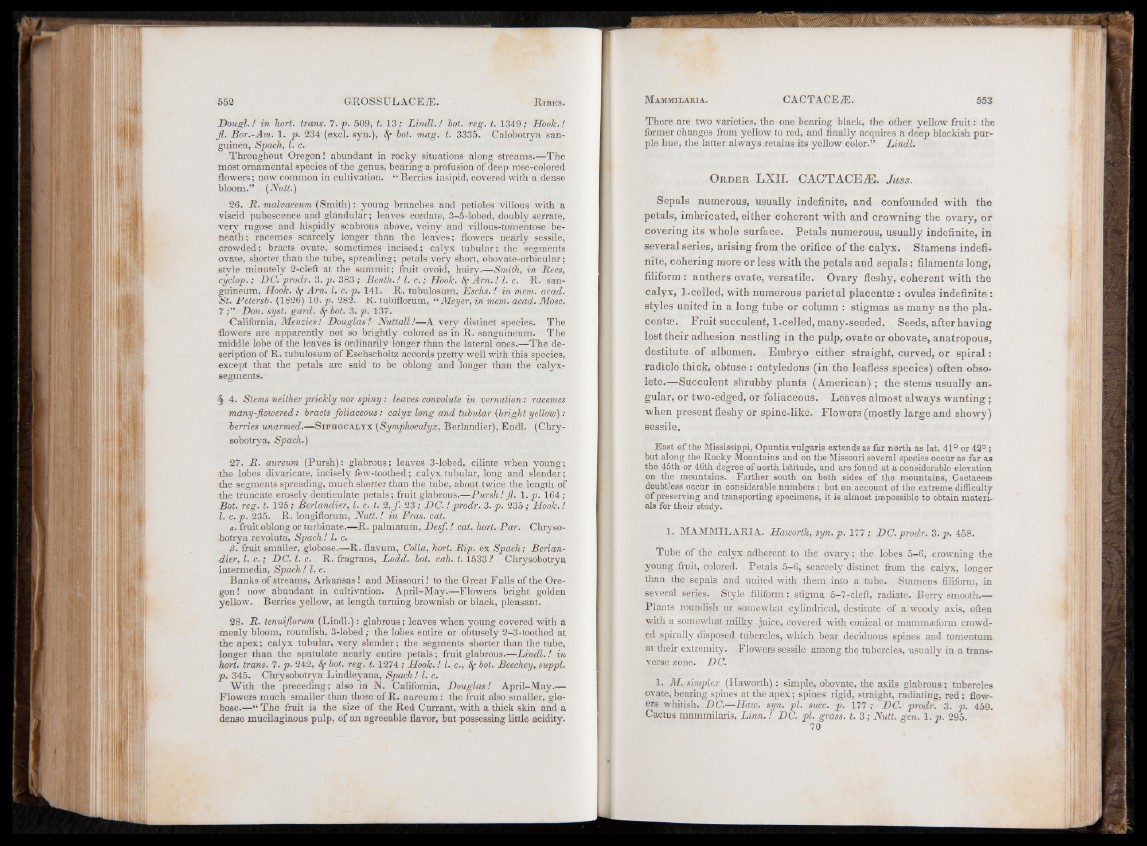
Dougl.! in hort. trans. 7. p. 509, t. 13; Lindl.! hot. reg. t. 1349; LToole.!
ji. Bor.-Am. 1. p. 234 (excl. syn.), Sf hot. mag. t. 3335. Calobotrya san-
guinea, Spach, l. c.
Throughout Oregon! abundant in rocky situations along streams.—The
most ornamental species of the genus, bearing a profusion of deep rose-colored
flowers; now common in cultivation. “ Berries insipid, covered with a dense
bloom.” (Nutt.)
26. R. malvaceum (Smith); young branches and petioles villous with a
viscid pubescence and glandular; leaves cordate, 3-5-lobed, doubly serrate,
very rugose and hispidly scabrous above, veiny and villous-tomentose beneath;
racemes scarcely longer than the leaves; flowers nearly sessile,
crowded; bracts ovate, sometimes incised; calyx tubular; the segments
ovate, shorter than the tube, spreading; petals very short, obovate-orbicular;
style minutely 2-cleft at the summit; fruit ovoid, hairy.—Smith, in Rees,
cyclop.; DC. prodr. 3. p. 383; Benth.! 1. c.; HooJc. Sf A m .! 1. c. R. san-
guineum, Hook. Sf Am. 1. c. p. 141. R. tubulosum, Eschs.! in mem. acad.
St. Petersh. (1826) 10. p. 282. R. tubiflorum, “Meyer, in mem. acad. Mosc.
7 ;” Don. syst. gard. Sf hot. 3. p. 137.
California, Menzies! Douglas! Nuttall!—A very distinct species. The
flowers are apparently not so brightly colored as in R. sanguineum. The
middle lobe of the leaves is ordinarily longer than the lateral ones.—The description
of R. tubulosum of Eschscholtz accords pretty well with this species,
except that the petals are said to be oblong and longer than the calyx-
seginents.
§ 4. Stems neither prickly nor spiny: leaves convolute in vernation: racemes
many-flowered: bracts foliaceous: calyx long and tubular (bright yellow):
berries unarmed.—S iphocalyx (Symphocalyx, Berlandier), Endl. (Chrysobotrya,
Spach.)
27. R. aureum (Pursh): glabrous; leaves 3-lobed, ciliate when young;
the lobes divaricate, incisely few-toothed; calyx tubular, long and slender;
the segments spreading, much shorter than the tube, about twice the length of
the truncate erosely denticulate petals; fruit glabrous.—Pursh! fl.. 1. p. 164 ;
Bot. reg. t. 125; Berlandier, l. c. t. 2, ƒ. 23; DC.! prodr. 3 .p. 235; Hook.!
1. c.p. 235. R. longiflorum, Nutt.! in Fras. cat.
a. fruit oblong or turbinate.—R. palmatum, Desf.! cat. hort. Par. Chrysobotrya
revoluta, Spach ! 1. c.
0. fruit smaller,.globose.—R. flavum, Colla, hort. Rip. ex Spach; Berlandier,
l. c. ; DC. 1. c. R. fragrans, Lodd. bot. cab. 1.1533? Chrysobotrya
intermedia, Spach ! 1. c.
Banks of streams, Arkansas! and Missouri! to the Great Falls of the Oregon!
now abundant in cultivation. April-May.—Flowers bright golden
yellow. Berries yellow, at length turning brownish or black, pleasant. 28
28. R. tenuiflorum (Lindl.): glabrous; leaves when young covered with a
mealy bloom, roundish, 3-lobed; the lobes entire or obtusely 2-3-toothed at
the apex; calyx tubular, very slender; the segments shorter than the tube,
longer than the spatulate nearly entire petals; fruit glabrous.—Lindl.! in
hort. trans. 7. p. 242, Sf bot. reg. 1. 1274 ; Hook.! 1. c., Sf bot. Beechey,.suppl.
p. 345. Chrysobotrya Lindleyana, Spach ! 1. c.
With the preceding; also in N. California, Douglas! April-May.—
Flowers much smaller than those of R. aureum: the fruit also smaller, globose.—“
The fruit is the size of the Red Currant, with a thick skin and a
dense mucilaginous pulp, of an agreeable flavor, but possessing little acidity.
There are two varieties, the one bearing black, the other yellow fruit: the
former changes from yellow to red, and finally acquires a deep blackish purple
hue, the latter always retains its yellow color.” Inndl.
Or d e r LXII. CACTACEtE. J uss.
Sepals numerous, usually indefinite, and confounded with the
petals, imbricated, either coherent with and crowning the ovary, or
covering its whole surface. Petals numerous, usually indefinite, in
several series, arising from the orifice o f the calyx. Stamens indefinite,
cohering more or less with the petals and sepals : filaments long,
filiform : anthers ovate, versatile. Ovary fleshy, coherent with the
calyx, 1-celled, with numerous parietal placentae : ovules indefinite:
styles united in a long tube or column : stigmas as many as the placentae.
Fruit succulent, 1-celled, many-seeded. Seeds, after having
lost their adhesion nestling in the pulp, ovate or obovate, anatropous,
destitute o f albumen. Embryo either straight, curved, or s p ir a l:
radicle thick, obtuse : cotyledons (in the leafless species) often obsolete.—
Succulent shrubby plants (Am e ric an ); the stems usually an-
gular, or two-edged, or foliaceous. Leaves almost always w a n tin g ;
when present fleshy or spine.like. Flowers (mostly large and showy)
sessile.
East of the Mississippi, Opuntia vulgaris extends as far north as lat. 41° or 42° ;
but along the Rocky Mountains and on the Missouri several species occur as far as
the 45th or 46th degree of north latitude, and are found at a considerable elevation
on the mountains. Farther south on both sides of the mountains, Caetacece
doubtless occur in considerable numbers : but on account of the extreme difficulty
of preserving and transporting specimens, it is almost impossible to obtain materials
for their study.
1. MAMMILARIA. Haworth, syn. p. 177; DC. prodr. 3. p. 458.
Tube of the calyx adherent to the ovary; the lobes 5-6, crowning the
young fruit, colored. Petals 5-6, scarcely distinct from the calyx, longer
than the sepals and united with them into a tube. Stamens filiform, in
several series. Style filiform: stigma 5-7-clefl, radiate. Berry smooth.—
Plants roundish or somewhat cylindrical, destitute of a woody axis, often
with a somewhat milky juice, covered with conical or mammseform crowded
spirally disposed tubercles, which bear deciduous spines and tomentum
at their extremity. Flowers sessile among the tubercles, usually in a transverse
zone. DC.
1. M. simplex (Haworth): simple, obovate, the axils glabrous; tubercles
ovate, bearing spines at the apex; spines rigid, straight, radiating, red; flowers
whitish. DC.—Haw. syn. pi. succ. p. 177 ; DC. prodr. 3. p. 459.
Cactus mammilaris, Linn. ! DC. pi. grass, t. 3 ; Nutt. gen. 1. p. 295.